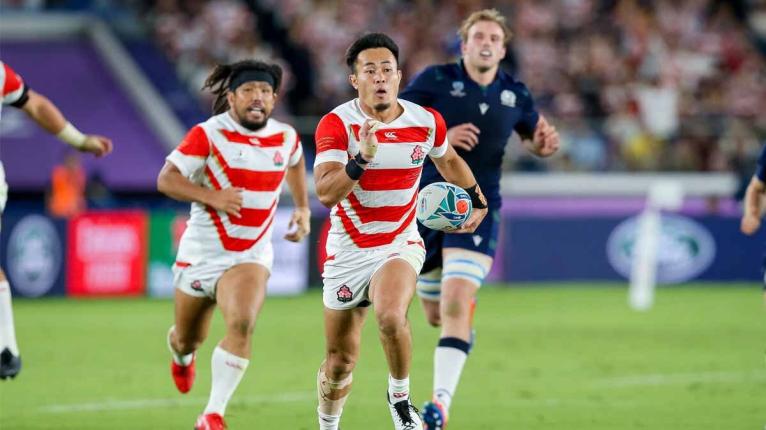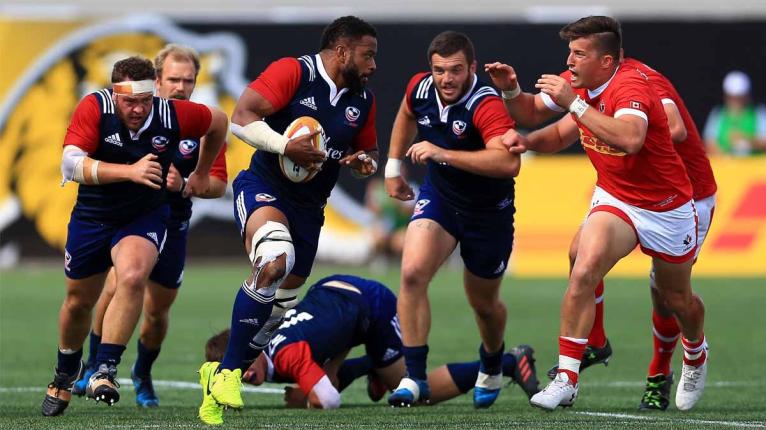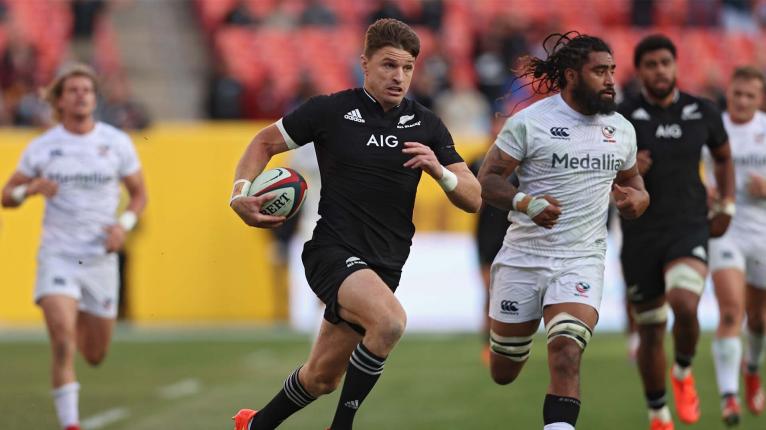There once was a time where the USA Eagles were more than a match for Japan’s Brave Blossoms and were viewed as the next big thing in world rugby.
Based just on the weekend’s results, that’s no longer the case.
While Japan fought tooth-and-nail to secure their best-ever result against an almost full-strength Wallabies side, falling 32-23 in Oita, the Eagles were put to the sword by a makeshift All Blacks team, conceding over 100 points in Maryland.
Of course, it was already well-known before the weekend that Japan have made huge strides over the last decade, thanks to their successes at the 2015 and 2019 World Cups, but the USA’s comparable downfall hasn’t been quite so obvious.

The two sides’ history as rivals dates back to 1985 when the USA triumphed by a solitary point in their first encounter with Japan in Tokyo. The teams squared off regularly until 1991, with each game falling the way of the States.
A four-year gap preceded the next clash, before the Pacific Rim Championship kicked off in 1996 and Japan earned their first win.
The Eagles continued to dominate the fixture, however, racking up 12 wins from the 16 encounters played until 2003.
There were some big victories along the way for the Eagles.
In the second fixture of 1996, played just three weeks after the Brave Blossoms’ first win of the rivalry, the USA bounced back to thrash Japan 74-5 – despite the two teams making few changes to their line-ups. Less than a year later, the Eagles again cracked the half century and then did the same at the beginning of 2003, winning 69-7 in San Francisco.
Since 2008, the two nations have squared off on eight occasions. Just one of those clashes has fallen the way of the Eagles, who snared a five-point 23-18 victory in Sacramento in 2015.
As had happened a little over a decade earlier, the rivalry was put on ice for four years and not reignited until the reinvention of the Pacific Nations Cup in 2008.
The USA may have dominated their rivalry with Japan up until that second hiatus, but it was at that point that things swung dramatically in Japan’s favour.
Since 2008, the two nations have squared off on eight occasions. Just one of those clashes has fallen the way of the Eagles, who snared a five-point 23-18 victory in Sacramento in 2015.
Although the USA had been on top for the first 20 years, there was a seismic shift in the balance of powers with Japan during that four-year gap between 2003 and 2008, and it can be credited to two major factors.

First of all, the Japan squad played 49 matches during that period compared with the USA’s 32. Games against tier-one and their B-sides were relatively evenly split (especially when considering that even the premier teams rarely fielded first-string sides) but it was at the next level down that the real differences were felt.
While the Eagles actually played more games against tier-two sides than the Brave Blossoms (16 to 12), half of their matches were against North American rivals Canada – who have undertaken an even more rapid downwards slide. Japan, meanwhile, were facing off against the likes of Samoa, Tonga and Fiji – nations the USA battled just twice.
The bigger change, however, was happening closer to home.
In 2003, the Japan Rugby Football Union introduced the Top League to replace the three major regional competitions.
The Top League (rebranded to Rugby League One for the future) was made up of the top 12 teams from throughout the nation and was Japan’s first major step towards professionalism.
The professionalism of rugby union in 1996 wasn’t necessarily entirely embraced with open arms by Japan, but it certainly led to a higher quality of players and that effect was only multiplied upon the introduction of the Top League, which ensured the best teams were playing the best teams and the best players were able to focus on the sport – not on their duties for their company.
While the sides were still run by private companies (and many players were full- or part-time employees of the company), the number of full-time professional players in the competition continued to trend upwards – as did the number of foreign players – and there was considerably more freedom of movement between teams.
Although there’s still a sizeable discrepancy between the best and worst sides in the league, the competition across the board has increased and even back in 2003, when the Top League was first introduced, the impacts were swift.
The professionalism of rugby union in 1996 wasn’t necessarily entirely embraced with open arms by Japan, but it certainly led to a higher quality of players and that effect was only multiplied upon the introduction of the Top League, which ensured the best teams were playing the best teams and the best players were able to focus on the sport – not on their duties for their company.
When Japan and the USA squared off in 2003, the players were on relatively even pegging, being sourced primarily from amateur sides.

Five years later, that was no longer the case. While Japan’s Top League had helped them steadily improve the player-base from which the Brave Blossoms could select their squad – and they were then able to hone their craft against the likes of Samoa and Fiji in the test arena – development in the US had stagnated.
It wasn’t until 2016 that the United States were able to get a professional competition up and running – aptly dubbed PRO Rugby. The 12-round league survived just one season, however, before a lack of finances saw the whole organisation fold.
Two years later, Major League Rugby was born. While the majority of players are still forced to spend the better part of the year working outside of the realms of rugby (thanks, in part to the USD 500k salary cap), the competition is continuing to grow and expand.
The United States fielded a 23 selected entirely from MLR players in their match against the All Blacks on the weekend. That was partly dictated by the game being played outside the regulation window, which mean the Eagles didn’t have access to some of their European stars, but even in their unsuccessful World Cup qualifiers against Uruguay, there was just a smattering of talent in the line-up from around the world with the vast majority products of the MLR.
Covid has forced many a change to scheduling in 2021 and in years to come, it’s highly likely that a New Zealand selection will still tour to the USA in order to both make a pretty penny for NZR, and grow the game in the Americas – but it’s unlikely to be the All Blacks themselves.
They were well and truly dealt to by the All Blacks – that came as no surprise – and many were quick to criticise the match taking place at all, but there’s a bigger picture at play here.
In an ideal world, it wouldn’t have been the All Blacks taking on the Eagles, it would have been an All Blacks XV, selected from players who weren’t already included in a 32-man first-choice squad.
While Ian Foster didn’t field a top-strength side, there were at most a handful of players on display that wouldn’t make the cut for New Zealand’s top squad.
Covid has forced many a change to scheduling in 2021 and in years to come, it’s highly likely that a New Zealand selection will still tour to the USA in order to both make a pretty penny for NZR, and grow the game in the Americas – but it’s unlikely to be the All Blacks themselves.
And while a belting at the hands of one of the best teams in the world isn’t ideal, those who are suggesting it will turn US fans off the sport are entirely off-base.

If the Argentina football side toured NZ and played the All Whites, support would turn out in droves – for both teams – and even if New Zealand suffered a heavy defeat, children from around the country would be enamoured with the sport thanks to the skills of the opposition and be encouraged to pick up the ball.
That’s the beauty of the All Blacks putting on a showcase in developing rugby nations: they play such an appealing style of game that fans of USA, Japan or any other tier-two sides will still enjoy the spectacle, even if their own team is put to the sword.
The USA may not have progressed at the same rate as Japan – perhaps they’ve even regressed since the early 2000s – but the advent of Major League Rugby and an ostensibly large commitment from NZ to tour America mirrors the steps made in Japan which have seen the game go from strength to strength.
It’s why American fans have reason to be optimistic – and it’s why a State-side World Cup could be just the tonic needed to catapult the game into the mainstream.
There’s still plenty of ground to be made and the USA aren’t going to turn into world-beaters anytime soon, especially if their development is left to chance, but it certainly isn’t out of the question that the game could fight itself into the higher echelons of sport in America, and that should have rugby fans around the world salivating.


Comments
Join free and tell us what you really think!
Sign up for free